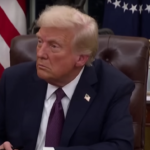The Dow Jones Industrial Average (DJIA) has entered a period of heightened volatility following the U.S. government’s recent announcement of new tariffs on key trading partners, including China, Canada, and Mexico. The move has sent shockwaves through Wall Street, with the Dow tumbling over 400 points before staging a partial recovery. The tariffs, designed to protect American industries, have instead fueled fears of inflation, economic slowdown, and trade war escalation.
The Dow Jones plunged more than 400 points in early trading on February 3, 2025, as investors scrambled to reassess their positions amid the uncertainty surrounding the tariffs. The market drop was driven by fears of a trade war escalation with China, the world’s second-largest economy, concerns over increased costs for U.S. companies relying on imported goods, and investor anxiety over supply chain disruptions in key industries, including technology, automotive, and retail. The impact was not limited to the Dow Jones; the Nasdaq and S&P 500 also suffered losses, reflecting a broad sell-off in the U.S. stock market. The sudden downturn raised alarms on Wall Street, with analysts warning that prolonged tariff disputes could severely damage economic growth.
The U.S. government’s decision to impose tariffs on goods from China, Canada, and Mexico was aimed at reducing trade deficits and protecting American manufacturing jobs. However, the unintended consequences include higher consumer prices, as tariffs increase the cost of imported goods, which in turn raises prices for American consumers; increased inflationary pressures, as businesses pass higher costs onto customers, fueling inflation, which weakens consumer purchasing power; disrupted supply chains, as many industries rely on materials and components from China, Mexico, and Canada, making sourcing more expensive and complicated; and reduced corporate profits, since higher costs cut into earnings for companies that rely on global supply chains, negatively impacting stock prices. Investors reacted to these concerns by selling off stocks in affected industries, contributing to the Dow’s steep decline.
Midway through the trading session, markets bounced back slightly after news broke that the U.S. government would delay tariffs on Mexico. The delay helped ease immediate concerns, as investors speculated that negotiations could still prevent a full-scale trade war. This led to a partial recovery in the Dow Jones, trimming some of its earlier losses. However, uncertainty remains, and investors are still wary of future developments in trade policy.
The tariff announcement has affected several major sectors of the U.S. economy in different ways. The technology sector has been hit particularly hard. Companies such as Apple, Nvidia, and Microsoft rely on components from China for their products. With increased tariffs, production costs are expected to rise, leading to lower profit margins. The automotive industry is also under pressure, as tariffs on Canadian and Mexican imports will increase the cost of cars and trucks in the U.S. Companies like Ford, General Motors, and Tesla are closely watching the situation, as higher vehicle prices could weaken consumer demand. Retail giants like Walmart, Target, and Amazon import large amounts of goods from China. Tariffs on these products mean higher prices for consumers, which could reduce sales and hurt earnings. The energy sector has been more resilient, with oil prices remaining stable. However, tariffs on key materials used in energy production could still pose long-term risks.
With the Dow experiencing sharp fluctuations, investors are adjusting their strategies to navigate the uncertainty. During periods of market volatility, investors often move towards safe-haven assets such as gold, which is considered a hedge against inflation and economic instability; U.S. Treasury Bonds, which offer security during uncertain times; and defensive stocks, including companies in healthcare, consumer staples, and utilities, which tend to perform better during market downturns. Some investors are capitalizing on market swings by engaging in short-term trading, taking advantage of price fluctuations in major stocks. Financial advisors are recommending portfolio diversification to minimize risks associated with the tariffs. Spreading investments across different sectors and global markets can help reduce exposure to U.S. stock volatility.
The ripple effect of U.S. tariffs is being felt globally, with international stock markets also seeing volatility. The Shanghai Composite and Hong Kong’s Hang Seng Index experienced sharp losses, as China faces increased trade tensions with the U.S. The FTSE 100 (UK) and DAX (Germany) remained volatile, as investors weigh the potential impact of U.S. tariffs on European exports. Countries reliant on trade with the U.S. are facing currency depreciation and stock market declines. The strength of the U.S. dollar in response to trade uncertainty has further complicated matters for global economies, making it more expensive for other countries to trade with the U.S..
If tariffs remain in place for an extended period, the long-term economic impact could be severe. Slower U.S. GDP Growth is a possibility, as higher business costs and weakened consumer spending could reduce economic expansion. Declining Business Confidence could emerge as companies delay investments due to uncertainty in trade policies. Potential Job Losses could happen, as industries reliant on global trade could be forced to downsize, leading to higher unemployment rates. Higher Interest Rates could follow, as if inflation worsens, the Federal Reserve may raise interest rates, making borrowing more expensive. The Federal Reserve and policymakers are monitoring the situation closely, with potential interventions to stabilize the economy if conditions deteriorate further.
The Dow’s sharp decline and partial recovery reflect the uncertainty surrounding U.S. trade policies. While delaying tariffs on Mexico helped ease some fears, the market remains on edge as investors await further developments. The Dow Jones initially fell 400+ points due to new tariffs on China, Canada, and Mexico. A tariff delay on Mexico helped the market recover some losses. Technology, automotive, and retail stocks suffered, while safe-haven assets gained. Investors are shifting towards gold, bonds, and defensive stocks to hedge against volatility. The long-term effects of tariffs could lead to higher inflation, slower economic growth, and potential job losses.
As the situation unfolds, investors must remain vigilant and adapt their strategies to navigate the uncertain economic landscape. The Dow’s movements in the coming weeks will provide critical insights into how markets and policymakers respond to the ongoing trade tensions. Stay tuned for further updates on the Dow Jones and the global market impact. 🚀






